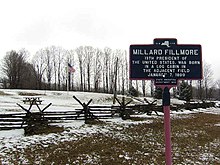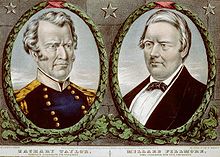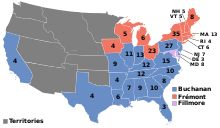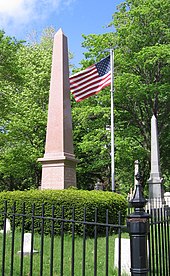Millard Fillmore
[16] Appreciating his son's talents, Nathaniel followed his wife's advice and persuaded Judge Walter Wood, the Fillmores' landlord and the wealthiest person in the area, to allow Millard to be his law clerk for a trial period.
[18] He left Wood after eighteen months; the judge had paid him almost nothing, and both quarreled after Fillmore had, unaided, earned a small sum by advising a farmer in a minor lawsuit.
[42] Van Buren, faced with the economic Panic of 1837, which was caused partly by the lack of confidence in private banknote issues after Jackson had instructed the government to accept only gold or silver, called a special session of Congress.
Van Buren's sub-treasury and other economic proposals passed, but as hard times continued, the Whigs saw an increased vote in the 1837 elections and captured the New York Assembly, which set up a fight for the 1838 gubernatorial nomination.
Fillmore did not attend the convention but was gratified when it nominated General William Henry Harrison for president, with former Virginia Senator John Tyler his running mate.
Weed's attempts to boost Fillmore as a gubernatorial candidate caused the latter to write, "I am not willing to be treacherously killed by this pretended kindness ... do not suppose for a minute that I think they desire my nomination for governor.
Weed told out-of-state delegates that the New York party preferred to have Fillmore as its gubernatorial candidate, and after Clay was nominated for president, the second place on the ticket fell to former New Jersey senator Theodore Frelinghuysen.
[54] Putting a good face on his defeat, Fillmore met and publicly appeared with Frelinghuysen and quietly spurned Weed's offer to get him nominated as governor at the state convention.
[64] With the nomination undecided, Weed maneuvered for New York to send an uncommitted delegation to the 1848 Whig National Convention in the hope of placing Seward on the ticket or getting him a Cabinet appointment.
[66] Nevertheless, there were sound reasons for Fillmore's selection, as he was a proven vote-getter from electorally crucial New York, and his track record in Congress and as a candidate showed his devotion to Whig doctrine, allaying fears he might be another Tyler were something to happen to Taylor.
The Democrats nominated Senator Lewis Cass of Michigan for president and General William O. Butler as his running mate, but it became a three-way fight since the Free Soil Party, which opposed the spread of slavery, chose ex-President Van Buren.
In late August, fearing that Taylor would be a party apostate like Tyler, Weed scheduled a rally in Albany aimed at electing an uncommitted slate of presidential electors.
Fillmore took the oath from Chief Justice Roger B. Taney and, in turn, swore in the senators beginning their terms, including Seward, who had been elected by the New York legislature in February.
[84] On January 29, Clay introduced his "Omnibus Bill",[h] which would give victories to both North and South by admitting California as a free state, organizing territorial governments in New Mexico and Utah, and banning the slave trade in the District of Columbia.
[94] In August 1850 the social reformer Dorothea Dix wrote to Fillmore to urge support of her proposal in Congress for land grants to finance asylums for the impoverished mentally ill.
[97] A longtime supporter of national infrastructure development, Fillmore signed bills to subsidize the Illinois Central railroad from Chicago to Mobile, and a canal at Sault Ste.
France, under Emperor Napoleon III, sought to annex Hawaii but backed down after Fillmore issued a strongly-worded message warning that "the United States would not stand for any such action.
[110] The Fillmores had planned a tour of the South after they had left the White House, but Abigail caught a cold at President Pierce's inauguration, developed pneumonia, and died in Washington on March 30, 1853.
Fillmore retained many supporters, planned an ostensibly nonpolitical national tour, and privately rallied disaffected Whig politicians to preserve the Union and to back him in a run for president.
In the early 1850s, there was considerable hostility toward immigrants, especially Catholics, who had recently arrived in the US in large numbers, and several nativist organizations, including the Order of the Star Spangled Banner, sprang up in reaction.
Queen Victoria is said to have pronounced the ex-president the handsomest man she had ever seen, and his coincidental appearance with Van Buren in the gallery of the House of Commons provoked a comment from the MP John Bright.
Fillmore made a celebrated return in June 1856 by speaking at a series of welcomes, beginning with his arrival at a huge reception in New York City and continuing across the state to Buffalo.
[124] Scarry suggested that the events of 1856, including the conflict in Kansas Territory and the caning of Charles Sumner on the Senate floor, polarized the nation and made Fillmore's moderate stance obsolete.
[j] The American Party ticket narrowly lost in several southern states: a change of fewer than 8,000 votes in Louisiana, Kentucky, and Tennessee would have thrown the election to the House of Representatives, where the sectional divide would have made the outcome uncertain.
After the vote, in which the Republican nominee, former Illinois Representative Abraham Lincoln, was elected, many sought out Fillmore's views, but he refused to take part in the secession crisis that followed, feeling that he lacked influence.
"[149] But Rayback applauds "the warmth and wisdom with which he had defended the Union",[150] and Smith finds Fillmore "a conscientious president" who honored his oath of office by enforcing the Fugitive Slave Act rather than govern based on his personal preferences.
"[159] Political scientist James E. Campbell defends Fillmore's legacy, writing, "Historians have underrated him, his detractors have unfairly maligned him, and the institutions he honorably served have disrespected him".
[161] His East Aurora house still stands, and sites honor him at his birthplace and boyhood home, where the Millard Fillmore Memorial Association dedicated a replica log cabin in 1963.
[148][164] According to the Miller Center of Public Affairs at the University of Virginia:[165] Any assessment of a President who served a century and a half ago must be refracted through a consideration of the interesting times in which he lived.
The first modern two-party system of Whigs and Democrats had succeeded only in dividing the nation in two by the 1850s, and seven years later, the election of the first Republican President, Abraham Lincoln, would guarantee civil war.















